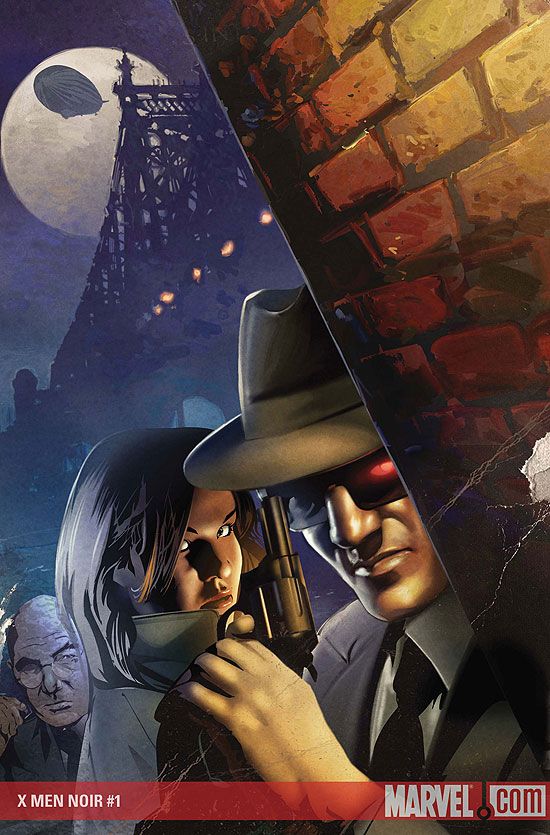Every time I write a review of a Fred Van Lente comic, I talk about him as a "rising star" or a "talent to watch," but now that he's writing so many Marvel comics these days, he's clearly a writer whose time has arrived.
Unfortunately, "X-Men Noir" #1 is his weakest work to date.
The problems with this first issue don't rest solely at the feet of Van Lente, but I'll get back to his missteps in a minute (that's a lot of foot-related metaphors, I know.) But a large part of the failure of "X-Men Noir" #1 comes out of the computer wizardry of artist Dennis Calero.
I've been paying attention to Calero's work over the past year or two, and his art has been moving away from hand-drawn panels toward computer-aided panels. Maybe that's always been his process, and he's been allowed to emphasize it more often lately, but his "X-Men Noir" work is more visibly Photoshop-based than his work on, say, "Legion of Super-Heroes." Even his "Legion" issues, though, had some jarring panels where a pose was repeated with a slight touch-up, as if the same photo had served as the reference for two different shots. But his "Legion" work still looked hand-drawn, even if it was computer-enhanced.
His work on "X-Men Noir" has reached Greg Land territory. And his use of celebrity photo reference is utterly annoying. Patrick Stewart as Xavier is bad enough (yet understandable), but this comic has David Niven playing a role, and Adrian Brody as the "Gambit" character -- albeit one with a tuxedo instead of a pink costume and trenchcoat. I'm sure I'm leaving out some other notable faces, but it's really very similar to the style Greg Land has used so egregiously since the post-CrossGen days. And Calero sometimes repeats the same exact panel multiple times on a page, without variation. I understand that it's an artistic choice, and it may indicate a passivity within a scene, but body language is an important part of storytelling, and having both characters in a scene sit in the same pose for panel after panel is a poor way to tell this particular story.
And it's not much of a story, unfortunately. The high concept is that it's a 1940s, fedora-heavy "noir" alternate reality, where Xavier is a disgraced psychiatrist and Bolivar Trask is a pulp sci-fi writer who spins tales of superhuman protectors. The X-Men are an underground clan of operatives, a shadowy group of mysterious characters who may or may not have powers beyond those of mortal men. It's not a bad concept, although Van Lente doesn't do much with it beyond the usual "What If" or "Elseworlds" approach, taking us through the paces of a world in which everything is different, but, really, it's kinda the same.
Van Lente's best decision is putting Thomas Halloway in the role of the detective in charge of solving the Jean Grey murder case. Having the death of Jean Grey at the center is a good inside joke, but Halloway is an absolutely inspired choice. You probably don't know Halloway, but he was the original Angel from Marvel's Golden Age. He appeared in "Marvel Comics" #1, from 1940, and he isn't much remembered these days. With him as the protagonist, Van Lente pits Marvel's obscure past against its most popular franchise, amidst the dark shadows of Hollywood noir.
I like all the parts of "X-Men Noir" far more than the whole, and every bit that sounds good in theory doesn't seem to work in execution. Maybe it's Calero's art that ruins any goodwill I might have toward this comic, but I found the first issue to be utterly disappointing, and I don't know that I'll stick around to find out if the series rises above its premise.

